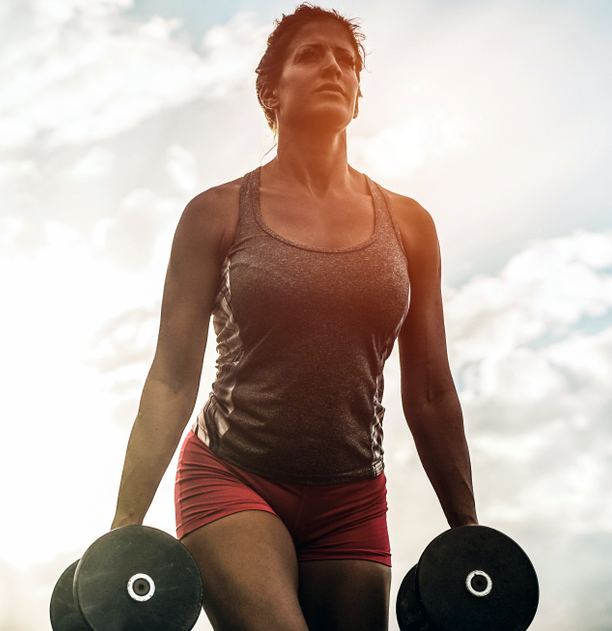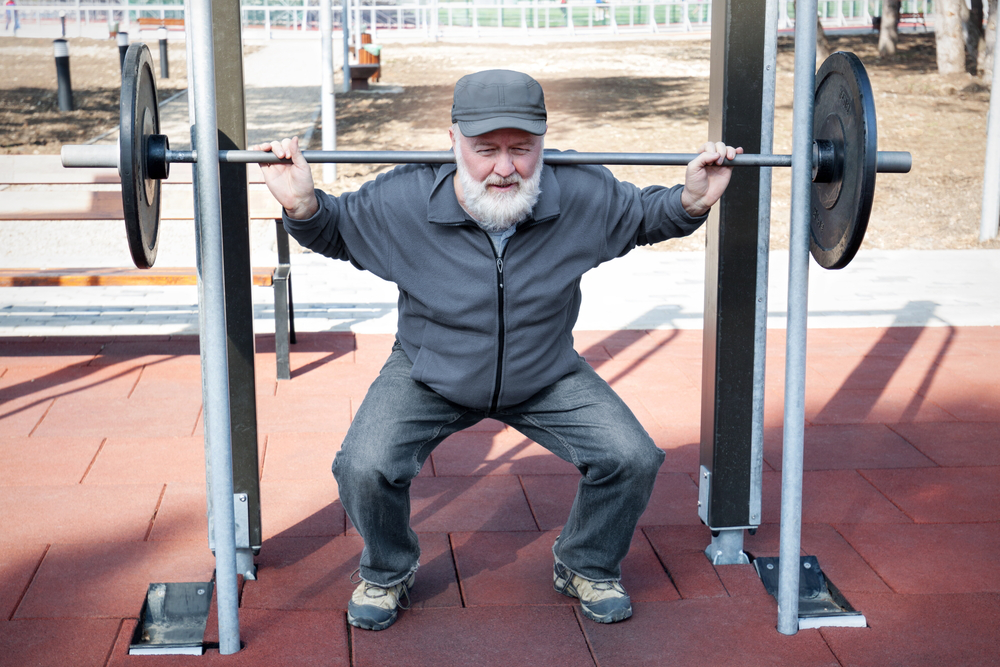Just because it gets harder to blow out all your birthday candles doesn’t mean you have to accept getting weaker.
Every month there seems to be more evidence why we should all be doing strength training as we get older, both for health benefits and a better quality of life. Despite this, many people over 40 are put off weight training because of injury (past or present), horrible soreness, and a lack of progress or results. Worse, there’s often even an acceptance that you can’t be strong or pack some eye-candy muscle well into your 40s, 50s and 60s, so what’s the point? Actually, you don’t have to accept any of this.
Dom Cadden
If you train smarter and recognise that there’s some things you just can’t get away with as you did when you were younger, you can get all the benefits of strength training without the pain. Sure, there is a natural age-induced decline in strength, but this relates to maximum exercise capacity. This means that if you were exercising perfectly and at your maximum effective capacity, your performance would decline. But who has exercised perfectly for 20 years? We all have capacity to improve the quality of our training, and the natural degeneration can be slowed. Mentally, age can be an advantage – we don’t even have to show you pics of the ‘nude triathlon’ we staged eleventeen beers into an office Christmas party to convince you of this. Older athletes are often smarter and much more researched about their training, while also having less ego get in the way and a greater respect and understanding of their body. Add in the tips below and you can reap the benefits of weights training for many years to come.
Crank it over gently
A few arm swings and a couple minutes on the bike no longer cut it as a warm-up. That little bit more time and attention to your warm-up will be the difference between injury/ going backwards and steady progress. Your warm-up should be constant movement that builds in intensity. Start with gentle mobility exercises (e.g. shoulder rotations, hip swings in every direction), then exercises for the core that use a full range of motion (e.g. standing and rotating from one side of your body to the other while holding a medicine ball,hanging leg raises/swings), and move on to targeted dynamic warm-ups that start to prepare you for specific exercises. Get advice on warm-up exercises that are right for your body and your training. I know it works – at one point I just accepted that, as a powerlifter and bench press competitor, I had chronic pain in one shoulder. I changed my warm-up and soon the pain went away and my bench press continued to improve.
You can fight against the decline and “make more of what we’ve got” by doing more speed work.
Always do warm-up sets for any exercise that you are going to do. It is better to do more warm-up sets of more graduations (e.g. 3 sets of 4 reps increasing weight in small increments) rather than pounding through one light set of 10.
Maintain
Strength and muscle are more easily lost when you are older, and they’re harder to get back again compared to when you were younger. There is a simple solution to this:
NEVER let yourself go!
Don’t neglect your training for long and avoid getting injured. The good news? It actually takes very little volume to maintain muscle and strength. You’ll get by with a short (even 30 minutes) session twice a week with few exercises,each of them using a large collection of muscles.
Recover
Sounds easy, but this part gets harder with age. It’s not something that just “happens” any more, you need to work at it. As you train more, sleep more and make sure you have quality sleep. You need your recovery nutrition immediately after training to help prevent soreness and promote regeneration in the muscle. Stretch, bust a few yoga moves, do some light cardio or just some gentle mobility movements after you train – avoid just sitting or slumping down on the couch! Let dedicated recovery compression do some of the work for you, improving blood flow to speed up muscle repair and to help reduce muscle swelling and soreness. Wear it for at least a couple hours,if not straight after training, then later in the day or while you sleep.
Don’t be stubborn and let a tiny problem become a big injury – and don’t let them halt your training altogether, either.
Schedule a deload week after about every 5-7 weeks training. Don’t wait for your body to fall apart or go into deep fatigue (or have strength go backwards). Reduce the stress on your body because you’re being smart, not because you’re forced to.
You have a need, for SPEED
We all have a mix of slow twitch muscle, which is more conditioned to endurance, and fast twitch muscle, which enables speed, strength and power. Unfortunately, there is a natural decline in the proportion of fast twitch muscle fibre we have as we age (as much as 30% decline between age 20 and 80), and an associated decline in total muscle mass. You can fight against the decline and “make more of what we’ve got” by doing more speed work.
Speed exercises can be both simple and safe, such as medicine ball throws done with speed and box jumps. Weighted exercises can include some modified Olympic lifts such as hang snatches. You can also perform more conventional weights exercises for speed, but for safety you could control the eccentric phase (when you are lowering a weight) and then lift the weight as fast as you can, e.g. lower a bench press slowly to your chest, then push up the weight as quickly as you can, pause, then repeat.
Speed exercises should be done with a relatively light weight that you can control and move very quickly. Keep reps in a range of 3-8 – stop the set if you start to slow down noticeably.
Park the ego

If you’re not 22 any more, then it’s a good idea to stop trying to max out a PB every session or even every week. You can still try for max lifts, but they need to be cycled into your training well apart from each other.
As you get older, you will benefit from a more controlled approach where you do more of your training with moderately-heavy weights. Research by scientists at the University of Connecticut showed that this high-volume, moderate-high intensity training with short intervals and stressing large muscle mass tended to produce the greatest acute elevations in hormones (notably testosterone and growth hormone). This also means less “grinding” sets. Better to do 4 sets of deadlifts with 3-5 reps, all done fast with perfect form and shorter rests, than grinding your way slowly through three sets of 6-8 and taking longer rests.
Here’s a sample challenge for experienced lifters: choose one exercise in your workout and take their six-rep maximum weight, then try to get to a total number of 30 reps, takings rests as needed of 45 seconds.
Cover your bases
As you get older, it’s important that your training – whether each training session or across each week – includes exercise done in strength, hypertrophy and speed formats. So your strength sets might be 3 x 3-5 reps at 85% of your maximum weight with two minute rest, hypertrophy might be 3 x 8 at 70-75% of maximum, and power 3 x 6 at 30% maximum. As you go through your training cycle you can vary the emphasis you put on each component.
Mix it up
Do other variations with your exercises to help prevent overuse injuries and help muscle growth by challenging your body to make adaptations. A good idea is to give yourself regular breaks from barbell exercises and to simply alter the grip or foot position you use on your exercises – make it wider,narrower, change the angle of the hand. Try placing pauses (holds) in your repetitions so you get some isometric work, too.
Learn and adapt
Another great thing about adding a swag of variations and additional exercises to your training repertoire is that there will always be time when you need to “work around” an injury or even just a niggle or some stiffness. Don’t be stubborn and let a tiny problem become a big injury – and don’t let them halt your training altogether, either.
Frequency beats duration
Do shorter workouts more frequently. Forty minutes, four days a week will work out better for your body than 80 minutes two days a week.
It’s never too late for yoga
“I’m not flexible enough” is no excuse to avoid yoga. You don’t have to go to a class, either – simple, effective moves are easily self-taught. I do yoga my way, thanks to a book I bought called Yoga Your Way. Yoga is great because it helps release the built-up tension and tightness in the muscles, not just through the long static stretches, but also by aligning your body properly and activating supporting and stabilising muscles. Try to get a few long poses in after training, or at least dedicate 20 minutes a couple times a week.
Dom Cadden was a World Masters Powerlifting Champion, and became a Commonwealth open-age powerlifting champion and bench press record-holder when he was 43.






